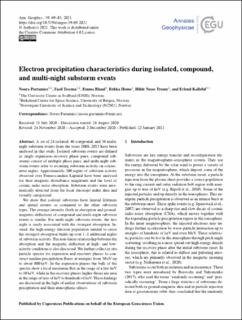| dc.contributor.author | Partamies, Noora | |
| dc.contributor.author | Tesema, Fasil | |
| dc.contributor.author | Bland, Emma | |
| dc.contributor.author | Heino, Erkka | |
| dc.contributor.author | Tyssøy, Hilde Nesse | |
| dc.contributor.author | Kallelid, Erlend Salte | |
| dc.date.accessioned | 2022-06-29T06:54:10Z | |
| dc.date.available | 2022-06-29T06:54:10Z | |
| dc.date.created | 2021-05-14T13:32:53Z | |
| dc.date.issued | 2021 | |
| dc.identifier.citation | Annales Geophysicae. 2021, 39 (1), 69-83. | en_US |
| dc.identifier.issn | 0992-7689 | |
| dc.identifier.uri | https://hdl.handle.net/11250/3001441 | |
| dc.description.abstract | A set of 24 isolated, 46 compound, and 36 multi-night substorm events from the years 2008–2013 have been analysed in this study. Isolated substorm events are defined as single expansion–recovery phase pairs, compound substorms consist of multiple phase pairs, and multi-night substorm events refer to recurring substorm activity on consecutive nights. Approximately 200 nights of substorm activity observed over Fennoscandian Lapland have been analysed for their magnetic disturbance magnitude and the level of cosmic radio noise absorption. Substorm events were automatically detected from the local electrojet index data and visually categorized.
We show that isolated substorms have limited lifetimes and spatial extents as compared to the other substorm types. The average intensity (both in absorption and ground-magnetic deflection) of compound and multi-night substorm events is similar. For multi-night substorm events, the first night is rarely associated with the strongest absorption. Instead, the high-energy electron population needed to cause the strongest absorption builds up over 1–2 additional nights of substorm activity. The non-linear relationship between the absorption and the magnetic deflection at high- and low-activity conditions is also discussed. We further collect in situ particle spectra for expansion and recovery phases to construct median precipitation fluxes at energies from 30 eV up to about 800 keV. In the expansion phases the bulk of the spectra show a local maximum flux in the range of a few keV to 10 keV, while in the recovery phases higher fluxes are seen in the range of tens of keV to hundreds of keV. These findings are discussed in the light of earlier observations of substorm precipitation and their atmospheric effects. | en_US |
| dc.language.iso | eng | en_US |
| dc.publisher | European Geosciences Union | en_US |
| dc.rights | Navngivelse 4.0 Internasjonal | * |
| dc.rights.uri | http://creativecommons.org/licenses/by/4.0/deed.no | * |
| dc.title | Electron precipitation characteristics during isolated, compound, and multi-night substorm events | en_US |
| dc.type | Peer reviewed | en_US |
| dc.type | Journal article | en_US |
| dc.description.version | publishedVersion | en_US |
| dc.source.pagenumber | 69-83 | en_US |
| dc.source.volume | 39 | en_US |
| dc.source.journal | Annales Geophysicae | en_US |
| dc.source.issue | 1 | en_US |
| dc.identifier.doi | 10.5194/angeo-39-69-2021 | |
| dc.identifier.cristin | 1910031 | |
| dc.relation.project | Norges forskningsråd: 287427 | en_US |
| dc.relation.project | Norges forskningsråd: 223252 | en_US |
| dc.relation.project | Norges forskningsråd: 302040 | en_US |
| cristin.ispublished | true | |
| cristin.fulltext | original | |
| cristin.qualitycode | 1 | |

